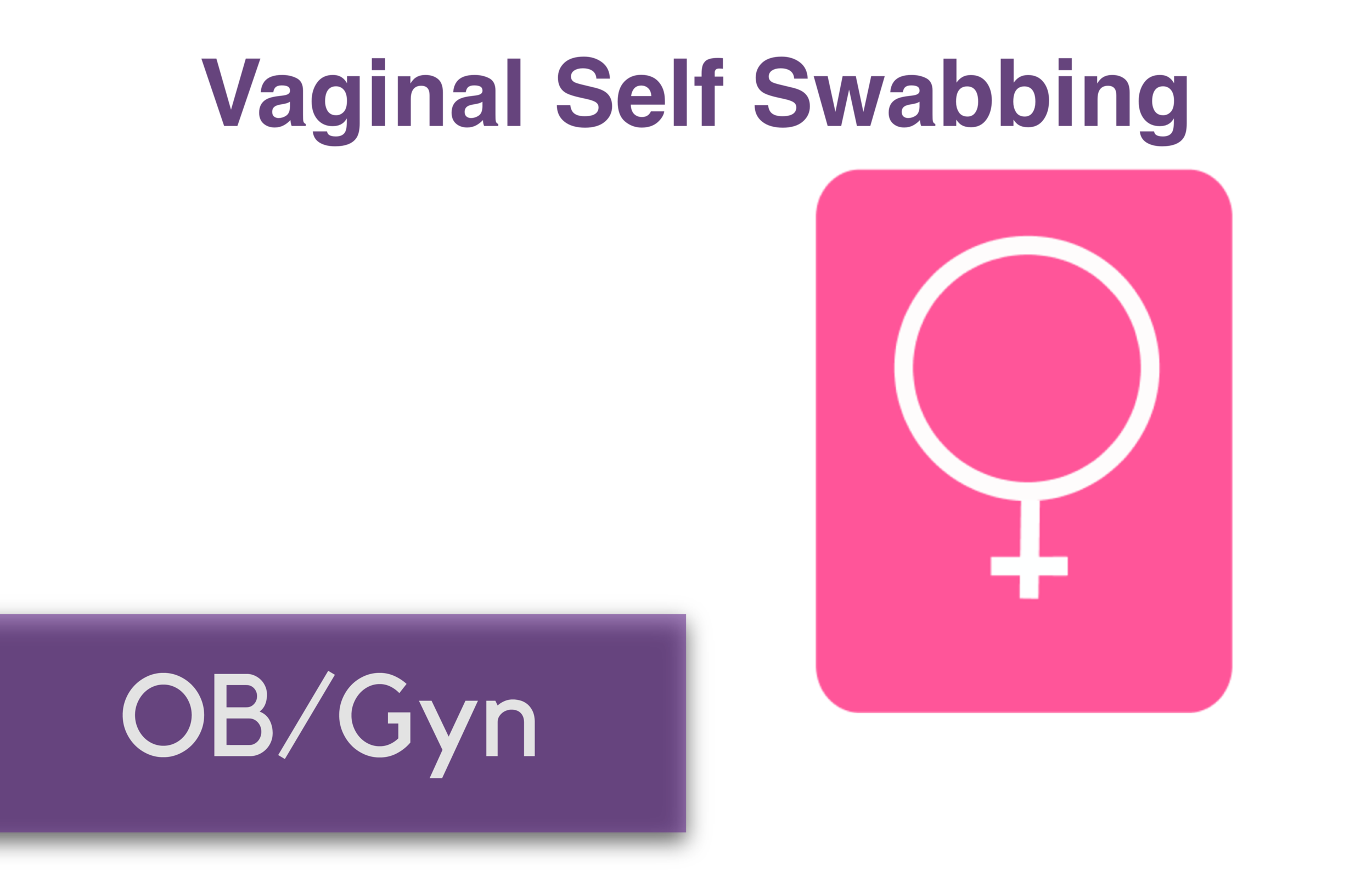Written by: Alex Herndon, MD (NUEM ‘21) Edited by: Vidya Eswaran, MD (NUEM ‘2020) Expert Commentary by: Matt Klein, MD, MPH
The Antiquated Pelvic Exam?
As Emergency Medicine physicians the demand to see more patients and expedite turnaround times all while providing quality care and maintaining patient satisfaction is steep. Our attempt to meet these standards is truly tried when posed with having to perform a pelvic exam during a busy shift. Introducing patient self-swabbing: an opportunity to provide quality care while saving precious time and resources.
Chlamydia is the most common infection reported in the United States, particularly among high risk populations such as females ages 15 to 24 [1]. These patients are most likely to present to the Emergency Department for their symptoms, thus it remains the task of the Emergency Medicine physician to screen and diagnose sexually transmitted infections to aid in avoiding complications of infection such as pelvic inflammatory disease, infertility, and ectopic pregnancy [1].
The gold standard for making the diagnosis has traditionally been through the physician-obtained endocervical swab on pelvic exam, an exam than has been shown to be physically and emotionally uncomfortable for a majority of patients, as well as low yield [2]. In 2012 a study at an urban sexual health center on women 16 years of age or older presenting with and without vaginal discharge or bleeding compared self-swabs to physician collected endocervical samples. Self-swabs were more sensitive in detecting chlamydia by nucleic acid amplification tests (NAAT) when compared to physician swabs; compared to self-swabs 1 out of 11 cases were missed by physician collected swabs, an overall 9% miss rate [3]. Patient self-swabs are equivalent to physician swabs in detecting gonorrhea [4] The difference in sensitivity has been attributed to patients having more contact time with the vaginal wall and removing more mucus when self-swabbing compared to when physicians collect samples [5].
Another study performed at two urban teaching hospitals in New York looked at self-swabs versus physician collected swabs in order to assess if self-swabs were as sensitive at diagnosing chlamydia infection within the Emergency Department. Overall self-swabs were 91% sensitive and 99% specific at identifying infection, thus deemed a reasonable alternative to physician collected samples, and implemented as an alternative in order to save time and resources.(6) Currently, self-swabbing is supported by ACOG, AAFP, and the CDC [2, 7, 8].
So why aren’t we doing this more? Inherently, as Emergency Medicine physicians, we are always seeking out the big, the bad, and the ugly, be it a fungating mass, or a case of pelvic inflammatory disease. While the idea of the self-swab shouldn’t obviate the pelvic exam, it can be useful in populations with a history and symptoms suggestive of a sexually transmitted infection, as well as for patients seeking screening after known exposure, or even for patients who refuse to undergo a pelvic exam [2, 7] In addition, patients prefer to obtain self-swabs.(8) While one can argue time is still lost in having to instruct the patient on how to self-swab, its practice in the outpatient clinical setting has become so common that there are numerous resources to aid in patient education, including easy-to-understand diagrams, like the one below, made to adorn bathroom walls [9].
Self swabs have been shown to be less messy, cost-effective, as well as thought to be easy to perform by the majority of patients [10]. When striving to increase efficiency, all the while improving patient care, every second counts. Self-swabbing is one method that can buy back time well-spent.
Expert Commentary
While this terrific post specifically focuses on the use of self-administered vaginal swabs for the evaluation of cervicitis in the emergency department, the broader utility of the pelvic exam for ED patients has been repeatedly called into question [1, 2]. As you correctly point out, pelvic exams are uncomfortable, can be distressing for patients, and frequently introduce delays in the patient’s care.
In addition to the evidence supporting self-swabs cited in this post, a 2018 ED-based study suggests the pelvic exam does not increase the sensitivity or specificity of diagnosing chlamydia, gonorrhea, or trichomonas when compared to taking a history alone [3]. While any individual study of this type will be limited by methodologic issues, there does appear to be broad support in the literature for routine use of self-administered swabs.
So why aren’t we doing this? Clinical practice can be slow to change, and that seems to be the case for this topic. I also think this highlights a fundamental feature of the emergency medicine mindset: the emphasis on identifying “bad” conditions, despite an anticipated low likelihood. While I have never personally visualized an unexpected cervical malignancy or traumatic injury during a pelvic exam in the ED, many emergency clinicians fear “missing something” in the absence of direct visualization. But as the 2018 paper highlights, taking an appropriate history should mitigate these concerns. Finally, as this post mentions, patients must be instructed on how to properly perform a self-administered swab, and any education should be appropriate to the patient’s primary language and degree of health literacy.
References
Close R, Sachs C, Dyne P. Reliability of bimanual pelvic examinations performed in emergency departments. West J Med. 2001;175(4):240-4.
Brown J, Aristizabal J, Fleming R, et al. Does pelvic exam in the emergency department add useful information. West J Emerg Med. 2011;12:208-212.
Farrukh S, Sivitz A, Onogul B, et al. The additive value of pelvic examinations to history in predicting sexually transmitted infections for young female patients with suspected cervicitis or pelvic inflammatory disease. Ann Emerg Med. 2018;72(6):703-712.
Dr. Matthew R Klein, MD, MPH
Assistant Professor of Emergency Medicine
Assistant Program Director
Department of Emergency Medicine
Northwestern Memorial Hospital
How To Cite This Post
[Peer-Reviewed, Web Publication] Herndon, A. Eswaran, V. (2020, Sep 7). Vaginal Self Swabbing. [NUEM Blog. Expert Commentary by Klein, M]. Retrieved from http://www.nuemblog.com/blog/vaginal-self-swabbing.
Other Posts You May Enjoy
References
Wiesenfeld H. Screening for Chlamydia trachomatis Infections in Women. New England Journal of Medicine. 2017; 376(22):2197-2198. doi:10.1056/nejmc1703640.
Smith R. The Unnecessary Pelvic Exam. Sinai-Grace Emergency Medicine Residency. http://emsgh.com/wp/the-unnecessary-pelvic-exam-dr-smith/.
Schoeman S, Stewart C, Booth R, Smith S, Wilcox M, Wilson J et al. Assessment of best single sample for finding chlamydia in women with and without symptoms: a diagnostic test study. BMJ 2012; 345:e8013
Stewart C, Schoeman S, Booth R, Smith S, Wilcox M, Wilson J et al. Assessment of self taken swabs versus clinician taken swab cultures for diagnosing gonorrhoea in women: single centre, diagnostic accuracy study. BMJ 2012; 345:e8107
Leon R. Indications and value of self-administered vaginal swabs for STIs and vaginitis. Faculty of Medicine: This Changed My Practice. November 2017. https://thischangedmypractice.com/self-administered-vaginal-swabs-sti-vaginitis/.
Berwald N, Cheng S, Augenbraun M, Abu-Lawi K, Lucchesi M, Zehtabchi S. Self-administered Vaginal Swabs Are a Feasible Alternative to Physician-assisted Cervical Swabs for Sexually Transmitted Infection Screening in the Emergency Department. Academic Emergency Medicine. 2009;16(4):360-363. doi:10.1111/j.1553-2712.2009.00359.x.
Lunny C, Taylor D, Hoang L, et al. Self-Collected versus Clinician-Collected Sampling for Chlamydia and Gonorrhea Screening: A Systemic Review and Meta-Analysis. Plos One. 2015;10(7). doi:10.1371/journal.pone.0132776.
Page C, Mounsey A, Rowland K. PURLs: Is self-swabbing for STIs a good idea?. J Fam Pract. 2013; 62(11):651-3.
Self-Collected Vaginal Swabs for Gonorrhea and Chlamydia. NC Sexually Transmitted Diseases Public Health Public Health Program Manual/Laboratory Testing and Standing Orders. 2011.
Fielder RL, Carey KB, Carey MP. Acceptability of Sexually Transmitted Infection Testing Using Self-collected Vaginal Swabs Among College Women. Journal of American College Health. 2013;61(1):46-53. doi:10.1080/07448481.2012.750610.













